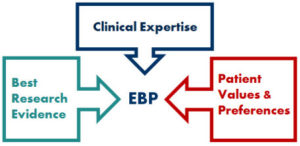What is Evidence Based Practice and how does it work along with Holistic Based Practice ?
What is Evidence-Based Practice (EBP)?
The most common definition of Evidence-Based Practice (EBP) is from Dr. David Sackett. EBP is “the conscientious, explicit and judicious use of current best evidence in making decisions about the care of the individual patient. It means integrating individual clinical expertise with the best available external clinical evidence from systematic research.” (Sackett D, 1996)
EBP is the Integration of clinical expertise, patient values, and the best research evidence into the decision making process for Client care. Clinical expertise refers to the clinician’s cumulated experience, education and clinical skills. The client brings to the encounter his or her own personal preferences and unique concerns, expectations, and values. The best research evidence is usually found in clinically relevant research that has been conducted using sound methodology. (Sackett D, 2002)
EBP Process Diagram
The evidence, by itself, does not make the decision, but it can help support the patient care process. The full integration of these three components into clinical decisions enhances the opportunity for optimal clinical outcomes and quality of life. The practice of EBP is usually triggered by patient encounters which generate questions about the effects of therapy, the utility of diagnostic tests, the prognosis of diseases, and/or the etiology of disorders.
Evidence-Based Practice requires new skills of the clinician, including efficient literature searching, and the application of formal rules of evidence in evaluating the clinical literature.

The Steps in the EBP Process:
ASSESS
the client
1. Start with the client — a clinical problem or question arises from the care of the patient
ASK
the question
2. Construct a well built clinical question derived from the case
ACQUIRE
the evidence
3. Select the appropriate resource(s) and conduct a search
APPRAISE
the evidence
4. Appraise that evidence for its validity (closeness to the truth) and applicability (usefulness in clinical practice)
APPLY:
talk with the client
5. Return to the client — integrate that evidence with clinical expertise, patient preferences and apply it to practice
Self-evaluation
6. Evaluate your performance with this client.
As you can see this type of Practice really does work with The Holistic Approach very well.. Here at SOHMAR we share this along with the Holistic Approach as well. The MIND BODY SPIRIT connection

